Deadlock Tournament Potential: Emerging Trends & Competitive Outlook
Updated On: November 29, 2025 by Aaron Connolly
Defining Deadlock Tournament Potential
Deadlock tournament potential basically captures how well Valve’s latest competitive game can pull in players, viewers, and sponsors for organized events. Early on, we’re already seeing some strong growth signals and real excitement from the competitive gaming crowd.
Key Indicators of Growth
Player Base Expansion stands out as the clearest sign of tournament potential. Deadlock’s invite-only system sparked genuine demand instead of just hyping things up.
During closed testing, thousands of players jumped in. This kind of organic momentum feels a lot like what we saw with CS2 and Dota 2 in their early days.
Tournament Infrastructure is springing up around Deadlock already. Several organizers are gearing up for 2025 events.
Early tourneys are mixing solo and team play. That flexibility gives organizers more room to experiment with event formats.
Community Engagement looks good too, with plenty of streaming and content popping up. Players are out there sharing gameplay clips and strategies all over social channels.
Significance in Competitive Gaming
Genre Innovation helps Deadlock stand out in the crowded MOBA scene. Valve mashed up hero-based gameplay with some new mechanics, so matches feel fresh and a bit unpredictable.
Valve’s experience with Counter-Strike and Dota 2 gives Deadlock a solid foundation. That history means organizers and players trust them to build something lasting.
Spectator Experience gets a boost from built-in replays and viewing tools. Organizers can showcase matches in a way that feels smooth and professional.
The game’s design makes it easy for casual fans to tune in, but there’s enough depth for serious analysts to dig into. That mix helps tournaments appeal to a wide range of viewers.
Professional Interest is picking up among big esports orgs. Teams and sponsors are keeping a close eye on the game’s progress.
Factors Driving Interest
Developer Support from Valve inspires confidence in the game’s future. Their commitment to competitive scenes usually means tournaments get the resources they need.
Valve’s past investments in prize pools and broadcasts set the bar high. Organizers are hoping for that same level of support with Deadlock.
Market Timing feels right for a new competitive title. Fans are hungry for fresh content, and the MOBA space could use some new ideas.
Betting and Media Interest is starting to show up as platforms cover Deadlock matches. This kind of attention usually hints at bigger tournaments on the horizon.
Media coverage right now mostly zooms in on Deadlock’s potential as an esport. That focus helps boost the game’s competitive reputation.
Community-Driven Events are popping up through grassroots efforts. When players run their own tournaments, it’s usually a good sign for the game’s competitive health.
Overview of Deadlock as a Competitive MOBA
Deadlock blends classic MOBA strategy with third-person shooter mechanics in a 6v6 setup. That combo is already pulling in pro esports talent.
The game’s complex movement system and crowd control abilities give it a steep skill ceiling. Its hybrid gameplay just feels different—maybe even a bit refreshing for the competitive scene.
Unique Gameplay Elements
Deadlock shakes up the MOBA formula by throwing in third-person aiming and lane strategy. Teams battle across several lanes, juggling resources and objectives, but here, you actually aim and shoot in real time instead of just clicking to attack.
The movement mechanics really separate new players from veterans. Advanced moves let skilled players stand out fast, which is pretty important if you want a game to last in the esports world.
Core gameplay features:
- 6v6 team battles with lanes and objectives
- Real-time shooting mixed into the action
- Complex movement tech for those who want to master it
- Classic MOBA staples like farming and item builds
Matches usually last around 26 minutes, which strikes a nice balance. Games are quick enough to stay exciting, but there’s still room for real strategy.
Deadlock’s Esports Appeal
Pros from Overwatch and League of Legends have already jumped into Deadlock tournaments. Folks like Jake Lyon and ZP Rush are even casting games, so the scene’s getting some legit esports flavor.
Deadlock Fight Night has hosted 20+ tournaments just during alpha. Teams from North America and Europe have been battling for prize pools and helping lay the groundwork for the competitive scene.
The game’s complexity attracts strategic thinkers. Teams have to coordinate:
- Lane assignments and rotations
- Item builds and economy
- Crowd control timing and teamfights
- Movement and map control
During the alpha playtest, Twitch viewership hit 15.52 million hours. That’s a wild number for such an early stage and hints at strong future tournament viewership.
Hero Roster and Roles
Deadlock’s heroes focus more on crowd control and team coordination than solo fragging. Mo & Krill and Holliday have been dominating competitive play thanks to their teamfight control.
Each hero fits into classic MOBA roles, but with shooter elements mixed in. Supports still bring utility, but they’ve got to aim well, too. Damage dealers need to know where to stand and how to shoot.
Popular competitive heroes:
- Mo & Krill: Heavy crowd control, great for starting fights
- Holliday: Versatile CC and strong positioning tools
- Grey Talon: Long-range DPS, needs protection
- Kelvin: Tank who can deny areas
Right now, the meta leans hard into crowd control comps. Teams put their resources into heroes who can lock down enemies, then set up big teamfights around those abilities.
Sometimes, teams pull out a surprise pick like Vyper in big matches. The meta’s not totally figured out yet, so risk-takers can still catch opponents off guard.
Major Deadlock Tournaments
The biggest Deadlock tournaments bring together huge prize pools and top-tier gameplay. Three main types of events lead the way: flagship events with £10,000+ prizes, regional competitions, and exclusive international invitationals.
Flagship Events
The 1win Bombshell series is Deadlock’s main tournament franchise. Each event comes with a £10,000 prize pool and pulls in big viewer numbers.
These tournaments regularly hit over 40,000 peak viewers. The latest Bombshell Vol.5 drew 34,326 viewers over 63 hours of matches.
FISSURE Underworld is another major event, boasting a £15,000 prize pool. It’s one of the largest Deadlock tournaments so far.
This one peaked at 127,443 viewers, with nearly 14,000 watching at the same time. The event ran for 18 hours across three days in October 2024.
Flagship events usually last 5-6 days. They use double-elimination brackets and often have more than 32 teams fighting for the top spot.
Regional Showdowns
Asia Pro League leads the charge for regional tournaments. Season 1 had a £315 prize pool and focused on Asian talent.
The event took place over two days in March 2025. Regional tournaments like this help discover new stars who might move up to the big leagues.
First Strike tournaments are all about grassroots competition. With £100 prize pools, these monthly events attract 100-300 viewers.
Even with smaller prizes, First Strike events see solid engagement. One recent tournament pulled in 152 viewers and lasted almost five hours.
Regional showdowns typically host 16-32 teams. These events often serve as qualifiers for bigger international competitions and help grow local scenes.
International Invitationals
OLIMPBET Deadlock Rivals nails the invitational format. The £10,251 event brought together hand-picked teams from different regions.
It hit 17,632 peak viewers in just 9 hours of broadcast. Invitation-only events like this make for intense, high-level matches.
Deadlock Fight Night Europe is a regular invitational series. These £1,000 events happen monthly and feature a rotating cast of invited teams.
Fight Night events keep pulling strong numbers. The Europe edition got close to 25,000 viewers and almost 10,000 peak streams.
International invitationals usually feature 8-16 teams. Organizers pick teams based on recent results and regional balance.
Notable Deadlock Tournament Organisers
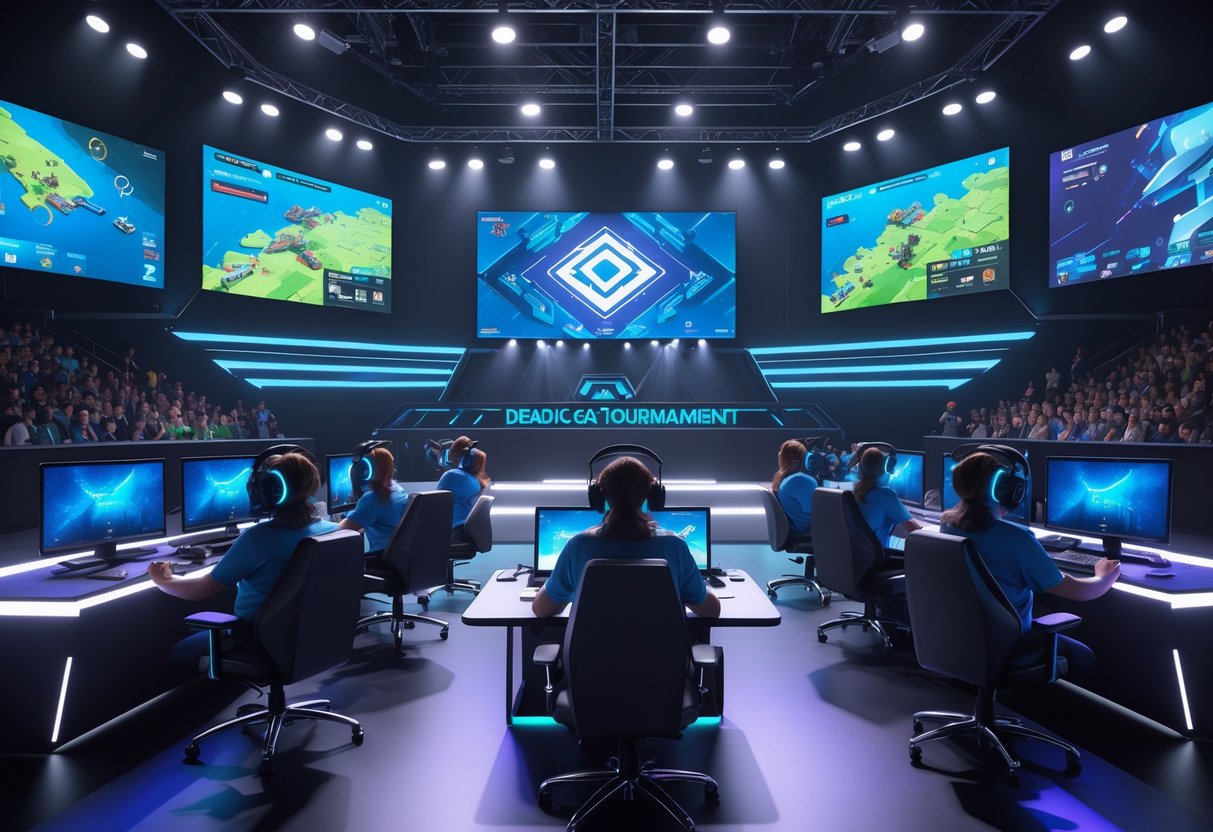
A handful of key players are shaping the Deadlock tournament scene, from grassroots events to established esports platforms. These organizers play a big role in how competitive Deadlock grows.
FISSURE Underworld Initiatives
FISSURE has become one of the most reliable Deadlock tournament organizers. They focus on structured, competitive environments for both amateurs and semi-pros.
The group built a reputation for paying out prizes on time and delivering solid broadcasts. FISSURE events usually feature prize pools between £500 and £2,000.
Key FISSURE Features:
- Monthly tournaments, always on schedule
- Clear brackets (single and double elimination)
- Live streams with pro commentary
- Open sign-ups for all skill levels
Their sign-up process is simple. Teams just fill out their info and roster on the website.
FISSURE events usually get 32-64 teams, which keeps things competitive but not overwhelming for newcomers.
Community-Driven Competitions
Smaller community organizers fill important gaps in the tournament ecosystem. They focus on local groups and specific player communities.
Discord servers and gaming groups run weekly tournaments. Prize pools stay modest (£50-£200), but plenty of players show up.
Popular Community Formats:
- Weekly 16-team brackets
- Beginner-only events
- Regional showdowns
- University leagues
A lot of pro players actually got their start in these grassroots events. The laid-back vibe helps new teams get valuable experience.
Community tournaments usually use simple bracket tools like Challonge. Entry fees run about £5-10 per team, which goes toward the prize pool.
Professional Esports Platforms
Big esports platforms are starting to host Deadlock tournaments. These groups bring better production values and bigger prizes.
Platform Advantages:
- Broadcast teams with real experience
- Larger audiences thanks to marketing
- Reliable tech infrastructure
- Connections for team sponsorships
1win esports leads the way right now, with six tournaments under their belt. Their events feature actual qualifying rounds and playoffs.
Prize pools range from £1,000 to £10,000. Registration is stricter—teams often need to verify rosters and sign player contracts.
These tournaments expect teams to have some competitive history. The skill level is a notch above most community events.
Format and Structure of Deadlock Events

Deadlock tournaments use different formats to keep things fair and interesting for both players and viewers. Most events mix qualifying rounds with bracket-style playoffs and organized prize payouts.
Qualifiers and Group Stages
Deadlock tournaments usually kick off with open qualifiers, so any team can jump in. These rounds use single elimination or the Swiss system to narrow down the field.
Single elimination qualifiers move quickly. Teams play one game—win and advance, lose and you’re out. It’s efficient for big crowds but doesn’t give much room for mistakes.
Swiss system qualifiers are a bit more forgiving. Teams play several rounds against others with similar records. This setup rewards consistency and gives strong teams more chances to shine.
Group stages come next in bigger tournaments. Usually, teams play round-robin matches within their group, facing every other team once. The top finishers move on to the playoffs.
Some events use custom brackets that mix and match formats. Hybrid systems help organizers fit specific team numbers or time limits.
Playoff Systems
Most Deadlock events use single elimination brackets for playoff rounds. Teams get knocked out after just one loss, which cranks up the drama and keeps viewers hooked.
Some premium tournaments go for double elimination brackets. This setup gives teams a shot at redemption through a losers’ bracket. If a team fights all the way back from the losers’ side, the winners’ bracket team still gets an edge in the grand finals.
League formats take a different approach for longer competitions. Teams play through extended seasons, earning points for wins and losses. Final rankings decide who takes home the championship and the prizes.
Bracket size just depends on how many teams sign up. You’ll see 8-team, 16-team, or 32-team brackets most often. Bigger brackets mean more games and more teams get a shot.
Prize Pool Distribution
Early Deadlock tournaments started out with tiny prize pools. The first one, back in June 2024, only had £96 up for grabs—pretty humble beginnings, honestly.
Smaller events sometimes use a winner-takes-all format. The champions walk away with everything, while everyone else leaves empty-handed.
Larger tournaments usually split prizes between the top teams. Winners get the biggest chunk—sometimes 50%—with second and third getting 30% and 20%. It’s a steep drop, but that’s how it goes.
Some events try a flat distribution instead, spreading the money more evenly. More teams get paid, but the top prize isn’t quite as tempting.
Regional differences play a role too. Local rules and sponsor preferences shape prize structures, and UK events often copy what’s worked in other esports.
Analysing Prize Pools and Sponsorship Trends

Deadlock’s tournament scene keeps growing, with prize pools ranging from $1,000 for weekly events up to $15,000 for the big majors. Sponsors like 1win Esports and GLuck Esports are jumping in, so there’s definitely belief in the game’s future.
Recent High-Value Tournaments
FISSURE holds the record for the biggest Deadlock tournament so far, putting up $15,000 in prize money over three days in October 2024. That set the standard for what a premium Deadlock event looks like.
A few organisations are making monthly tournaments a regular thing. 1win Esports hosts $10,000 events every month, giving pro teams a steady shot at real income.
GLuck Esports has also put on several high-value tournaments, with their November event reaching $10,842. Sponsors clearly see something worth investing in here.
The tournament scene feels more structured now. Weekly events offer $1,000 prizes for regular competition, and monthly majors go over $10,000 for the best teams.
Tournaments have started popping up all over—Europe, North America, CIS, Asia-Pacific. This global reach is pulling in sponsors who want their brands seen everywhere.
Sponsorship Influence in Esports
Big-name esports organisations are backing Deadlock tournaments with serious cash. Companies like OLIMPBET, Fonbet, and 1win bring their gambling partnerships into the mix.
Sponsorship in Deadlock follows a familiar pattern. Bigger prize pools attract stronger teams, which boosts viewership, and that keeps sponsors happy.
Gaming hardware brands and streaming platforms usually jump in once the audience gets big enough. Spacestation Gaming is already hosting events, so it’s starting.
University tournaments are showing up too, like the Deadlock Collegiate Series with its $5,000 prize pool. Educational sponsors seem to spot early potential for student engagement.
Weekly tournaments keep the content flowing. Sponsors like the predictable schedule—it makes planning marketing campaigns way easier.
Betting and Market Expansion
Gambling operators are getting involved in Deadlock, with OLIMPBET, Fonbet, and 1win sponsoring events. That’s usually a sign they trust the competitive scene and see room for growth.
Betting companies need frequent tournaments to keep people interested. Deadlock’s weekly events give them plenty of chances to offer bets.
Regional growth in places like Brazil, Thailand, and Asia-Pacific is opening up new revenue streams. Organisers tweak prize pools to fit local currencies and conditions.
With tournament tiers from $1,000 weeklies to $15,000 majors, there’s something for every betting fan—from casual to hardcore.
Betting operators look for games with clear formats and strong player bases. Deadlock’s regular schedule ticks those boxes, so it should keep growing.
Player and Team Development in Deadlock
Professional player development in Deadlock needs structure—training programs, talent pipelines, and performance tracking. Teams already invest in coaching and analytics to get ahead.
Coaching and Training Programmes
Deadlock’s 6v6 format brings some wild tactical demands. Teams need coaches who can handle lane assignments, objective timing, and team fight calls.
Most organisations bring in dedicated coaches for strategy. These coaches dig into match replays and set up training schedules. They also keep communication sharp when things get tense.
Training usually covers:
- Daily scrims against other teams
- Individual coaching for mechanical skills
- Strategy workshops on map control
- Mental training for tournament nerves
Pro teams grind 6-8 hours a day. That covers aim training, scrims, and strategy talks. Some even hire sports psychologists to help with stress.
The coaching market’s still young here. Coaches from other tactical shooters are jumping in, bringing their coordination skills to Deadlock.
Pathways for New Talent
New players start out in ranked matchmaking or amateur tournaments. The invite-only beta keeps the player pool small but focused on improvement.
Typical paths look like:
- Learning the basics in public matchmaking
- Joining amateur teams through Discord
- Playing in small tournaments with £100-500 prize pools
- Building a name through steady performance
Streaming and content creation are opening doors for semi-pros. Players who can both play well and entertain get noticed by teams faster.
University esports programs are starting to look at Deadlock. A few UK schools want to add it once the game launches fully.
The talent pipeline is still narrow because of the closed beta. Early masters will have a big edge when bigger tournaments arrive.
Player Performance Analytics
Teams track more than just kill/death ratios to measure performance. Deadlock’s objective-heavy gameplay needs deeper analysis.
Key stats include:
- Damage per minute in team fights
- Objective control percentage
- Economy management
- Support utility timing
Third-party analytics tools are popping up for Deadlock. These programs log player movements, ability usage, and decisions.
| Metric Type | Amateur Level | Professional Level |
|---|---|---|
| Match Review | Weekly | Daily |
| Data Analysis | Basic stats | Advanced metrics |
| Video Analysis | Occasional | Every match |
| Performance Tracking | Manual | Automated tools |
Pro teams pour resources into analysts who break down every detail. Their reports highlight weak spots and team issues so training stays focused.
The analytics scene should explode once the game launches and prize pools get bigger.
Community Involvement and Grassroots Events
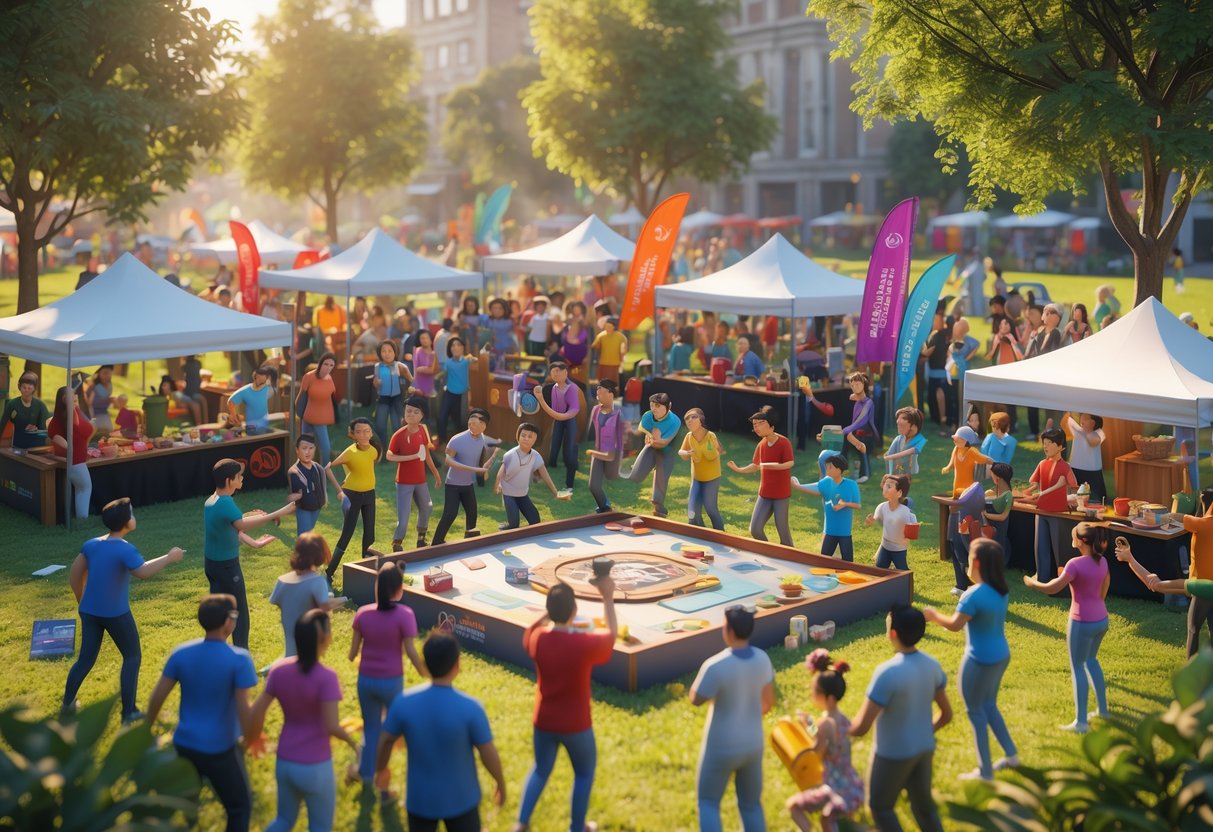
Deadlock’s competitive scene thrives on community tournaments and volunteers who pull players together. These grassroots events give newcomers a shot and help everyone build real connections in the scene.
Death Slam Events Impact
Death Slam Events has become a major tournament organiser for Deadlock. They set up structured competitions where players at any level can jump in.
Their tournaments feature real brackets and prize pools that draw serious players, but they’re still open enough for new faces.
The group cares about community engagement too, not just the games. Players get to network, learn from veterans, and maybe even find a team.
Quick win: Follow Death Slam Events on social media to catch tournament news and sign-up dates.
These tournaments help players gain experience before moving up to bigger events.
Volunteer Opportunities
Community tournaments really depend on volunteers. Deadlock events need folks for all sorts of jobs—stream mods, bracket managers, tech support.
Typical volunteer roles:
- Match observers and refs
- Stream chat moderators
- Bracket admins
- Social media helpers
- Tech support staff
Volunteering gets you right into the action. You’ll see how tournaments run and meet players, organisers, and other fans.
A lot of volunteers go on to organise their own tournaments. The experience is great for learning event management and building community.
Heads up: Some volunteer gigs need you evenings or weekends, since that’s when most tournaments happen.
Community Tournaments
Grassroots events like Deadlock Fight Night keep things lively, even with a smaller player base. Top players from games like Overwatch 2 often show up.
Collegiate events add another layer. University teams battle it out, giving student players a way to develop their skills.
Entry rules are all over the place. Some events are open to everyone, while others want only experienced players.
| Tournament Type | Entry Fee | Skill Level | Prize Pool |
|---|---|---|---|
| Weekly Community | Free-£5 | All levels | £50-£200 |
| Monthly Featured | £10-£25 | Intermediate+ | £500-£2000 |
| Collegiate | Free | Students only | Varies |
Next step: Hop into Deadlock community Discords to find tournaments and meet teammates before you play.
Technological Advancements in Tournament Play
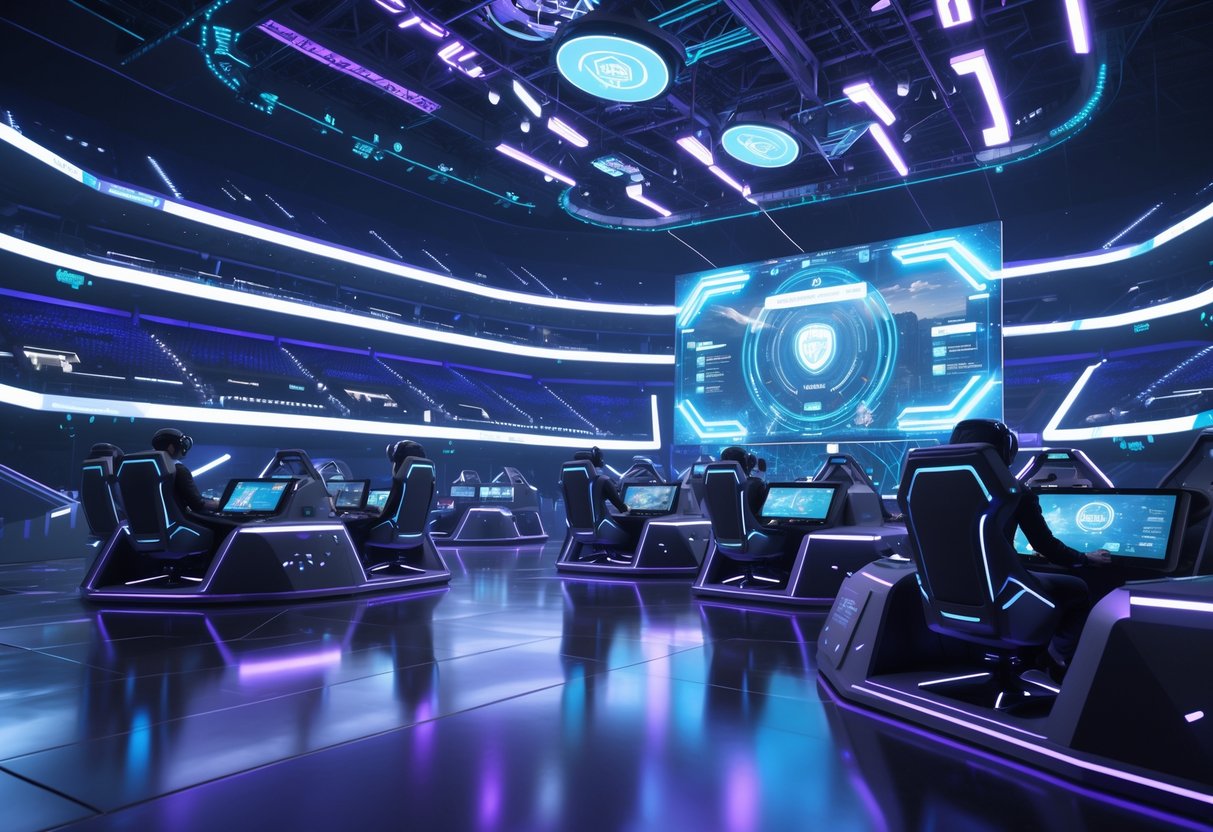
Modern tournament tech has totally changed Deadlock competitions. Matches run smoother, and fans get more stats and player info than ever.
Tournament Platforms and Tools
Organisers now rely on specialised software to run Deadlock tournaments from sign-ups to finals. These tools handle brackets, match times, and scoring automatically.
Challonge and Battlefy are pretty popular—they’re free for basic stuff, but advanced features run £15-30 a month. The platforms update standings and send out match reminders, so players stay in the loop.
Deadlock needs tools that track its unique mechanics. Custom overlays show soul counts, item builds, and lane assignments live. It’s way better for viewers than just a basic stream.
Bracket management software is a must as tournaments get bigger. Automated seeding uses player rankings, which means fewer mistakes and faster setups.
A lot of organisers use Discord bots that talk to the tournament platform. Players get match reminders and can report scores right in chat.
Real-Time Coverage Tools
Live coverage for Deadlock leans on advanced streaming tech. Broadcasters use OBS Studio with custom plugins (which can cost £50-100 for the good stuff) to juggle multiple camera angles and player POVs.
Real-time stat overlays show fans things like souls per minute, K/D ratios, and item progress. These pull straight from the game and update every few seconds.
Deadlock’s spectator tools let observers jump between players instantly. Broadcasts use this to keep up with the action across all the lanes.
Multi-stream setups let viewers pick their favorite player or camera. This does need dedicated servers, which can get pricey—£200-500 a month for big events.
Some tournaments now use AI-powered highlights that auto-clip big plays. It takes pressure off production teams and makes sure fans don’t miss the best moments.
Challenges and Opportunities for Deadlock’s Esports Scene
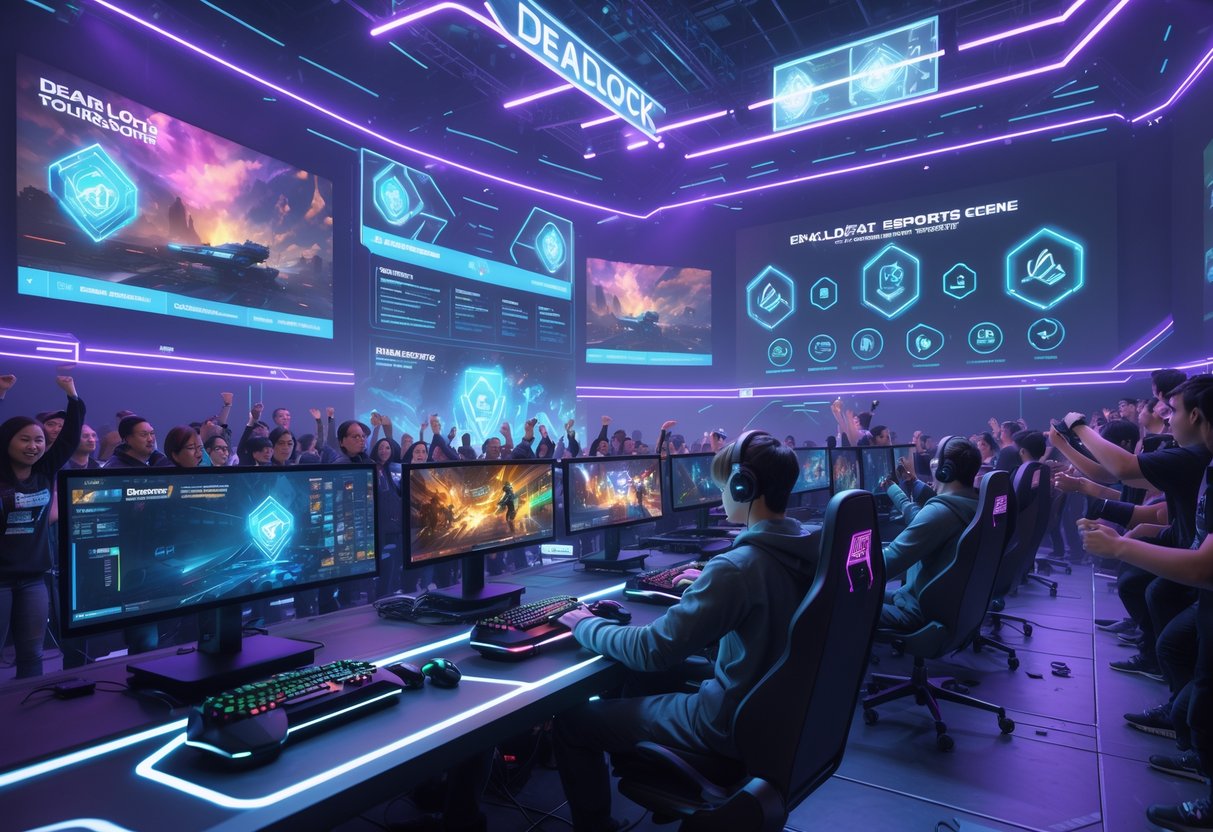
Deadlock faces some real challenges as it tries to break into the crowded MOBA and esports world. The game’s deep mechanics and a shrinking player base don’t help, but its grassroots community and Valve’s support still give it a fighting chance.
Market Fragmentation
The esports scene already feels crowded with big names like League of Legends, Dota 2, and CS2. Deadlock now has to fight for attention from viewers, sponsors, and professional players in this splintered market.
Right now, player numbers don’t look great. Deadlock peaked at 170,000 concurrent players in September 2024, but by 2025, that number dropped to about 10,000. This kind of sharp decline makes it tough for tournament organizers and sponsors to stay interested.
Professional players have some tough choices to make. Many top competitors are leaving Overwatch 2 for Deadlock, but the shaky player base makes that a risky move for anyone’s career.
Still, Deadlock’s MOBA-shooter mix gives it a shot at drawing in players from different gaming backgrounds. That could mean a broader audience than your typical MOBA.
Grassroots tournaments like Deadlock Fight Night show there’s real, organic interest in competition. These community events might lay the groundwork for bigger tournaments—if the player numbers stop falling.
Integration with Broader MOBA Ecosystem
Deadlock’s future really depends on how well it fits into the existing MOBA world. The game needs to win over current MOBA fans and also attract shooter players who want something new.
Broadcasting Deadlock isn’t easy. TenZ, a well-known pro, pointed out that Deadlock’s complexity makes it harder to watch than other big esports titles. Spectators need better observer tools and clearer visuals to follow the action.
Tournament formats need some rethinking, too. Deadlock’s shooter elements demand different camera angles and commentary styles. Organizers will have to invent new production standards to make it work.
Because Deadlock blends genres, new partnership options open up. MOBA teams might start Deadlock divisions, and FPS organizations could jump into the MOBA world for the first time. That’s a fresh mix.
Valve’s experience with Dota 2 gives them an edge on infrastructure. They know how to run MOBA tournaments and could use that know-how as Deadlock grows.
Scalability for Future Events
Right now, nobody’s sure how scalable Deadlock tournaments will be. Early events like the $10,000 afterMatch Esports tournament are just testing the waters. Bigger investments will only come if the player base holds steady.
Deadlock tournaments need more than just what traditional MOBAs use. The game requires dedicated servers, anti-cheat systems, and robust spectator modes for serious competition.
Prize pools can only grow if sponsors and viewers get on board. Community tournaments run on shoestring budgets, but real esports money won’t show up until Deadlock proves it can draw a crowd.
Expanding into different regions brings both headaches and hope. Deadlock has to build competitive scenes in multiple places at once if it wants to become truly global.
The game’s Early Access state makes long-term planning a pain. Organizers hesitate to commit when the game keeps changing with every update.
Collegiate tournaments look promising for nurturing new talent. These events help players develop and bring local communities into the Deadlock scene.
Predictions for Deadlock’s Competitive Growth
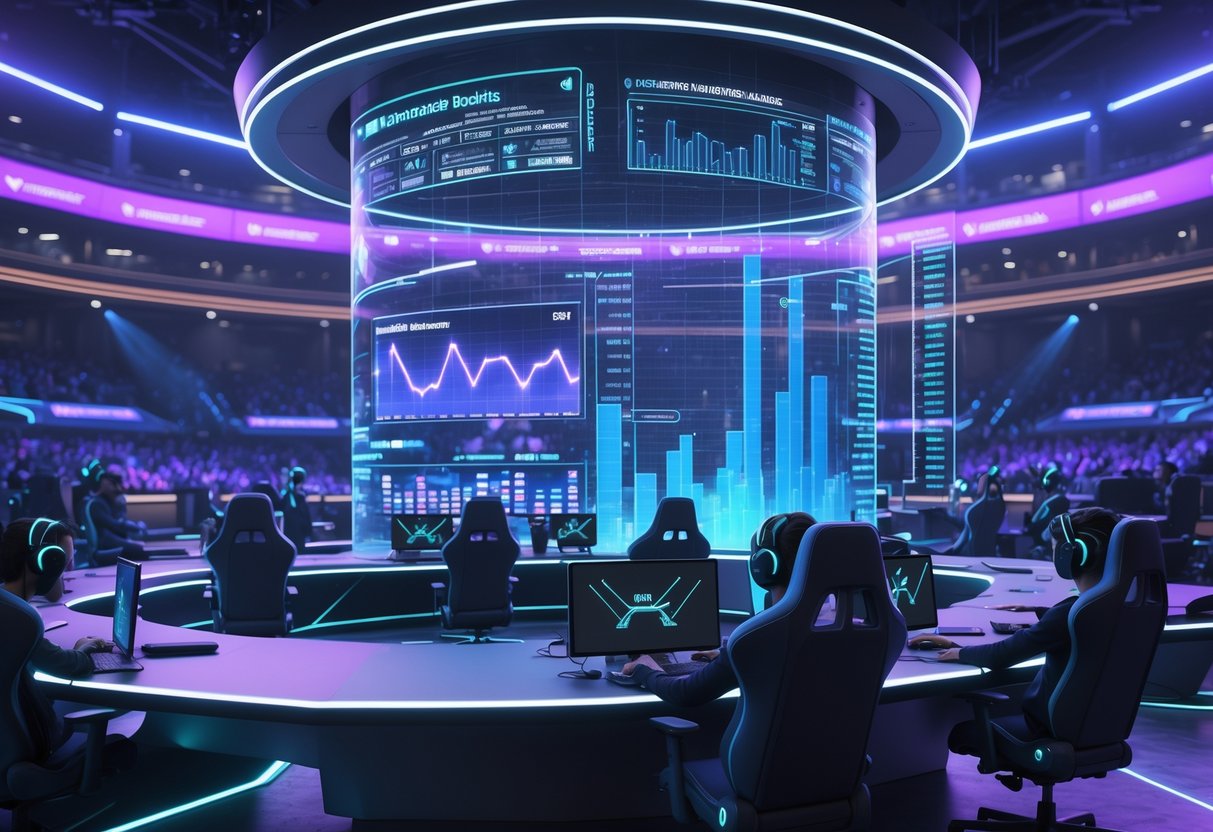
Deadlock’s tournament future depends on how well it can expand globally, keep up with esports trends, and build lasting competitive infrastructure. The game hit a high of over 170,000 concurrent players in September 2024, but by early 2025, it was down to around 10,000. That’s a big question mark for its competitive future.
Potential for Global Expansion
Deadlock could still grow well beyond its current PC audience. Its MOBA-shooter hybrid style appeals to fans of both genres, maybe even pulling in players from League of Legends, Dota 2, and Overwatch.
Some regions look especially promising. Asia—especially South Korea and China—usually embraces new MOBAs with strong esports scenes. Europe’s existing infrastructure could support Deadlock events right alongside other Valve tournaments.
Console and mobile expansion might be the biggest untapped opportunity. Games like Arena of Valor have shown that mobile esports can thrive, especially where PC gaming isn’t as popular.
Key growth drivers:
- Cross-platform play
- Local tournament circuits
- Regional sponsorships
- Game content that fits local cultures
But Deadlock still has to go up against games that already own these markets. Its success will depend on Valve putting in the effort for regional growth, not just hoping for a viral hit.
Influence of Esports Trends
The current esports landscape actually favors Deadlock’s style. More and more, fans want hybrid gameplay that blends genres, and that’s exactly Deadlock’s thing.
Streaming viewership matters more than ever. During its alpha, Deadlock racked up 15.52 million hours watched on Twitch. That’s a good sign—streamers and content creators are paying attention, and their audiences follow.
Today’s esports fans want shorter, punchier matches. Deadlock’s fast pace matches this trend and seems especially appealing to younger players.
What’s hot right now:
- Regular balance updates (Deadlock does this)
- Lots of characters for different strategies
- Spectator-friendly features for better broadcasts
- Community tournaments before big leagues roll out
Collegiate esports is on the rise, too. Universities want fresh games to stand out from the usual CS2 and League of Legends crowd, and Deadlock fits that bill.
Still, just chasing trends isn’t enough. If Deadlock doesn’t get steady developer support, it could fizzle out like so many others.
Long-Term Sustainability
Deadlock’s future really comes down to Valve’s commitment. Valve’s history with Dota 2 and CS2 shows they know how to back esports with real resources.
But developer consistency is a big concern. Deadlock’s frequent patches—new maps, heroes, major changes—make it hard for competitive teams to build strategies. Teams need a stable foundation to practice and compete.
Grassroots tournaments like Deadlock Fight Night keep the competitive flame alive, even with fewer players. This kind of organic scene can support bigger events down the line.
Sustainability hurdles:
- Prize funding without steady revenue
- Pro team investment during uncertain times
- Production costs for complicated broadcasts
- Player retention as the newness wears off
Financial health depends on attracting sponsors. Most sponsors want proven audiences, which makes it tough for new games to break in.
Honestly, keep an eye on community tournaments first. They’re the best way to judge Deadlock’s competitive health before any major events happen.
Valve’s full release timing in 2025 will be a make-or-break moment. If they wait too long, games like Marvel Rivals could steal the spotlight. Rush it, and they risk launching before the game’s ready.
Conclusion: Deadlock’s Place in Modern Esports
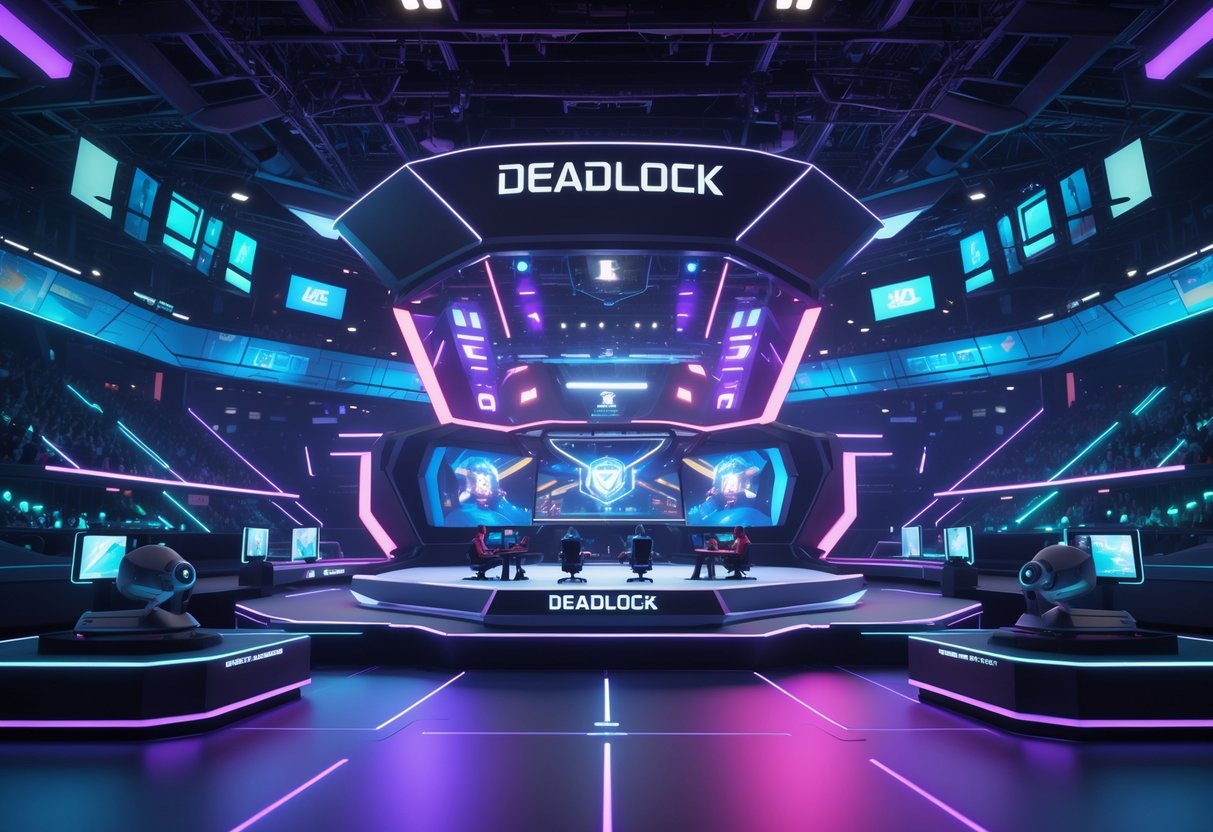
Deadlock sits at a turning point. Its MOBA-shooter hybrid could shake up competitive gaming. The game brings strategic depth to rival established titles, but it’s also pretty accessible for new viewers.
Want a quick win? Check out community tournaments like Deadlock Fight Night. You’ll see the raw competitive energy and maybe catch a glimpse of what organized Deadlock esports could look like.
The player base has its struggles. From a peak of 170,000, it’s now around 10,000 as of early 2025. Still, that’s not unheard of—other games have bounced back from similar dips during their early days.
Valve’s experience matters here. Their work on CS and Dota 2 means they know what competitive scenes need to thrive.
Grassroots tournaments keep proving there’s a real hunger for competition. Top Overwatch 2 players are already jumping in, and that kind of talent shift usually hints at something big.
Timing is everything. Deadlock needs to hit full release before competitors like Marvel Rivals steal the show. A clear roadmap from Valve would really help keep the hype going.
Here’s what needs work:
- Observer tools need to get better for fans watching at home.
- Game balance has to settle before big tournaments.
- Expanding across platforms could bring in way more players.
Deadlock probably won’t dethrone League of Legends or CS2, but it could carve out a loyal niche. The game’s complexity might keep it from going fully mainstream, but it could build a passionate community—kind of like Dota 2 has.
Frequently Asked Questions

Players always want to know which tournament tactics and character picks work best in Deadlock. Folks also ask where to catch tournament highlights or how to join special events.
What tactics are most effective during the First Deadlock Tournament?
Map control is the name of the game. Teams should grab key objectives early and keep vision over important areas.
Managing resources makes a huge difference. Coordinate your team’s spending so you hit item timings just right. Don’t waste souls early on.
Teamwork beats solo plays. Practice callouts and positioning in scrims. If you haven’t drilled communication, it’ll fall apart under pressure.
Quick win: Stick to one main strategy per match. Master the basics before you try anything fancy.
Where can one find highlight reels from the latest Deadlock Tournament on Twitch?
Tournament organizers usually upload highlights to their main Twitch channels within a day. Look for streams with “Deadlock” and “Tournament” in the title.
Popular streamers sometimes make their own highlight reels from different matches. Try searching “Deadlock Tournament Highlights” in Twitch’s video tab.
Some tournaments run separate highlight channels on social media. Check official tournament accounts for links.
Warning: Unofficial channels sometimes spoil results in thumbnails or titles. Watch out if you’re avoiding spoilers.
How has the player count for Deadlock evolved since its release?
Deadlock started with invite-only access, which made it feel exclusive and built up some hype. The small player pool during testing got people talking.
Every big tournament announcement brings in a wave of new players. Competitive events keep the community interested and growing.
The competitive scene attracts players who want something new. Lots of folks from other MOBAs and shooters have made the jump to Deadlock.
Tournament viewership keeps rising as the esports scene develops. The player base is still active, even if it’s smaller than at launch.
Could you share some tips for succeeding in Deadlock’s Fight Night events?
Drill your hero’s combos until you can pull them off without thinking. Fight Night rewards players who don’t freeze up under pressure.
Scout your opponents if you can. Many Fight Night players stream their practice, so you can pick up on their habits.
Warm up before matches. Spend at least half an hour in practice mode to get your aim and timing sharp.
Quick win: Play heroes you know inside and out. Fight Night isn’t the time to test new characters.
Who are currently considered the top characters in Deadlock as of 2025?
The meta changes with every patch and tournament. Right now, the best heroes dominate both the laning phase and team fights.
High-mobility picks are everywhere in top-level play. Heroes with dashes or escapes see tons of action.
Versatile supports are must-picks for every team. Teams want characters who can change up their builds depending on how the match is going.
Warning: Tier lists shift all the time. Focus on fundamentals, not just the current flavor of the month.
What are the key strategies for victory in the Downtown Showdown event within Deadlock?
Downtown Showdown really pushes teams to play aggressively right from the start. You shouldn’t just sit back and farm—jump in and contest objectives early.
If you build your team around team fighting, you’ll usually have a better shot at winning. The event favors frequent skirmishes, so split-pushing just doesn’t work as well here.
Teams that do well adapt between rounds. They tweak their item builds and change up their positioning based on what happened in the previous round.
Economy works a bit differently in Downtown Showdown. You’ll want to grab items that make an immediate difference, rather than just thinking about late-game scaling.

